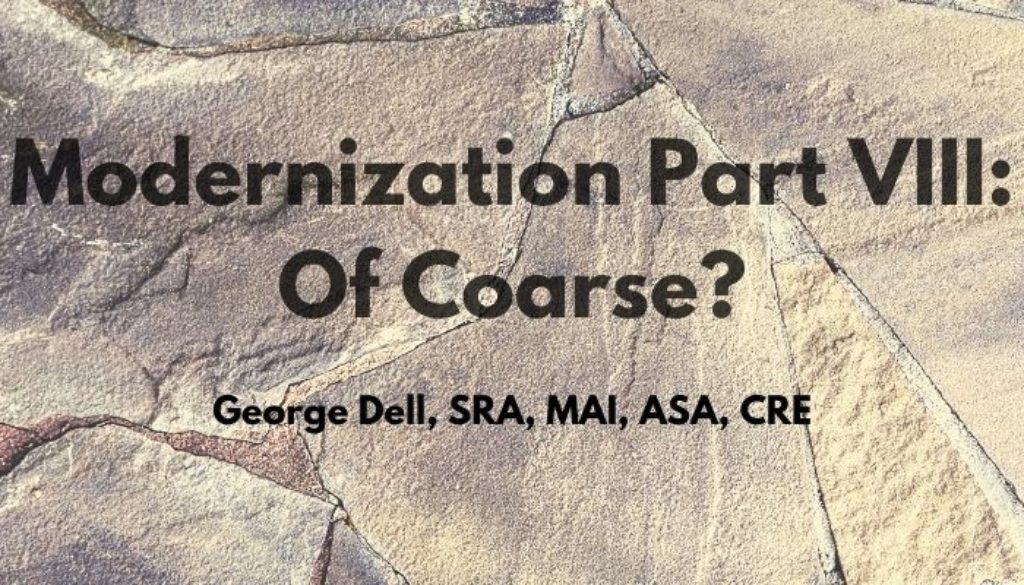For modernization, we must note how coarse are the choices available to the loan originator: AVM, appraisal, hybrid, waiver, evaluation. Each choice involves different, but pre-set steps. There is little flexibility. It is not a continuum of analytical depth.
To compare valuation systems to each other, we must look at the parts of the analysis, starting from the property identification through analysis to delivery. In comparing part by part, we clarify the advantages and problems of each system to include AVMs, traditional appraisal, hybrids, waivers, and evaluations. Each valuation structure comes with fixed foundations and fuzzy/blocked windows, and shiny roof. Each method provides a choice of market value or market price, called market value. Modernization must consider how coarse are the choices, and how we might create a measurable continuum of choices.
AVMs and appraisals follow consistent internal processes. AVMs provide fixed, secret objectivity, while appraisals provide compliant expert subjectivity . AVMs deliver a point value and a proprietary measure of variation, such as FSC (Forecast standard deviation) or CI (Confidence Interval). Appraisals deliver a point value, plus a narrative ‘reconciliation’ of the ‘three approaches’.
. AVMs deliver a point value and a proprietary measure of variation, such as FSC (Forecast standard deviation) or CI (Confidence Interval). Appraisals deliver a point value, plus a narrative ‘reconciliation’ of the ‘three approaches’.
Lenders and regulators are limited to granular choice: opaque objectivity (AVMs), or supported subjectivity (appraiser opinion). In-between choices involve reduced subject information, or eliminated personal viewing of comparable sales.
AVM algorithms are universally proprietary, kept secret lest competitors discover. The test of sureness (certainty) is also secret and proprietary by each company. As a result, there is no real consistency by which to compare performance of one AVM over another.
Appraisal support is universally questionable, based on ‘picking comps,’ then ‘making adjustments.’ There is no certainty calculation possible. Comps and adjustments support the appraiser’s opinion.
Other systems, such as ‘evaluations,’ BPOs (Broker Price Opinions), waivers, and hybrids can be typified as attempts to reduce the coarseness of the two original choices (AVMs/appraisals) to reduce cost and turn-time. No real attempt (to my knowledge) has specifically focused on improving results or measuring merit of results. Neither accuracy nor reliability are stated objectives of appraisal /AVM alternatives. Reliability/risk score is sacrificed for speed/cost. Appraisal cost typically is near 0.1% of the transaction price. (Other fees and commissions are 5% – 8%, for comparison.)
Proper modernization presents opportunity to improve accuracy and reliability. In addition it provides a continuum of service cost related to that accuracy, measurable precision and validity. Together, these move toward optimal risk reduction in each individual loan made, as well as the ability to provide a risk/reliability score. Such a reliability score for each property valuation can dramatically improve the input to risk models, and clarify model risk analytics, sharpen regulatory oversight, and provide consumer protections, including any inequitable valuation bias.
Modernization of valuation must, by definition, apply modern methods, tools, and competence. AVMs and legacy appraisal practice each have advantages, and disadvantages. Yet each, internally, has elements of superiority. So what might be a solution? How can we take the best of the human ‘carbon’ component, and the digital machine module?
Easy. We integrate and optimize the human sense with computer logic. Appraisers must learn to match models to analytic algorithms. This we do through graphs and numerical descriptives. Easy.
We must give up comparing comps, and learn to measure markets. Exploit complete data, computation, and visualization along with simple statistics. Simple.
